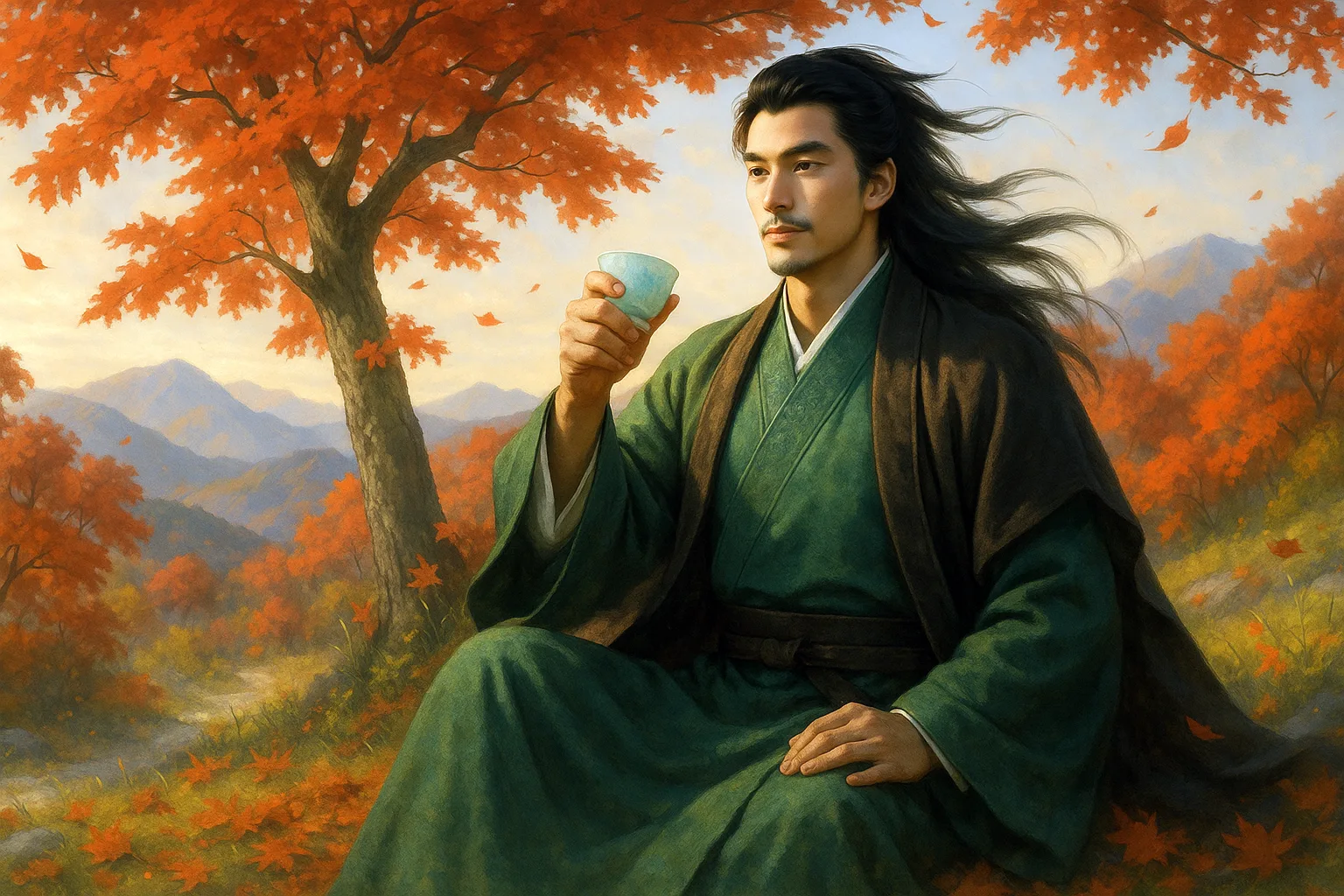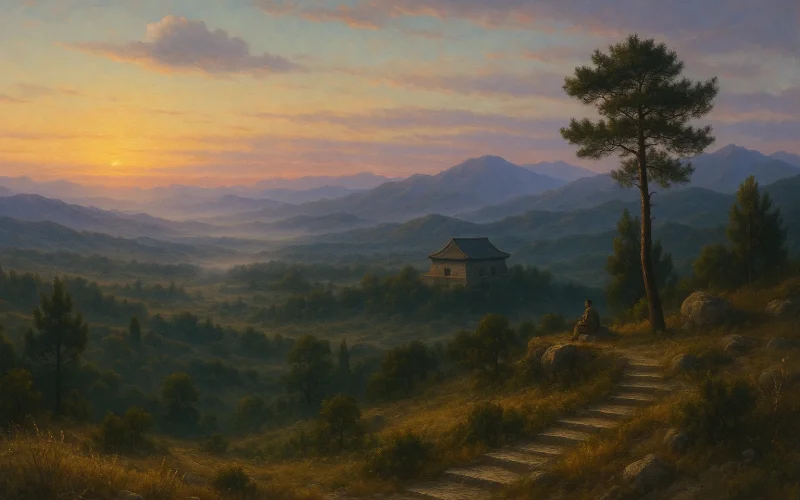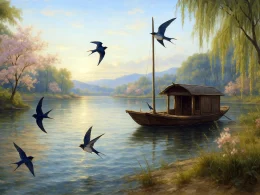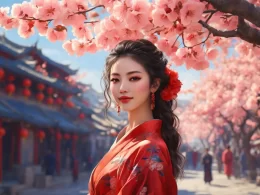There are faint green mountains and far green waters,
And grasses in this river region not yet faded by autumn;
And clear in the moon on the Twenty-Four Bridges,
Girls white as jade are teaching flute-music.
Original Poem
「寄扬州韩绰判官」
杜牧
青山隐隐水迢迢,秋尽江南草未凋。
二十四桥明月夜,玉人何处教吹箫?
Interpretation
"A message to Han Chuo the Yangzhou Magistrate" was written between 833 and 835 AD during the reign of Emperor Wenzong of the Tang Dynasty. At the time, Du Mu was serving as an assistant official under Niu Sengru, the military governor of Huainan, and later as a secretary. After leaving Yangzhou, Du Mu remained deeply attached to the scenic beauty and vibrant life of Jiangnan (the region south of the Yangtze River). This poem, written in remembrance of Jiangnan and in jest to his friend Han Chuo, blends nostalgia with a touch of playful elegance.
First Couplet: "青山隐隐水迢迢,秋尽江南草未凋。"
Qīngshān yǐnyǐn shuǐ tiáotiáo, qiū jìn Jiāngnán cǎo wèi diāo.
The green mountains fade into the distance; the river winds its way far and wide. Though autumn has ended, the grass of Jiangnan remains lush and green.
This couplet paints a broad and serene picture of Jiangnan in late autumn. The phrase "fading green mountains" (青山隐隐) captures the distant, undulating horizon, while "winding river" (水迢迢) emphasizes the river's meandering flow. Together, they create a tranquil and picturesque scene. The contrast between "autumn's end" (秋尽) and "grass still green" (草未凋) highlights Jiangnan's mild climate, where even in late autumn, nature retains its vitality.
Second Couplet: "二十四桥明月夜,玉人何处教吹箫?"
Èrshí sì qiáo míngyuè yè, yù rén hé chù jiào chuī xiāo?
On a moonlit night at the Twenty-Four Bridges, where is the fair one now, teaching the flute?
This couplet alludes to the famous "Twenty-Four Bridges" of Yangzhou and the tradition of playing the flute there. The "fair one" (玉人) refers to a beautiful woman, likely a playful reference to Han Chuo, whom Du Mu teases for his romantic escapades. At the same time, the line evokes the poet's own nostalgia for the vibrant nights of Yangzhou, where music, moonlight, and beauty once intertwined.
Overall Appreciation
This poem begins with a serene depiction of Jiangnan's autumn scenery, using the distant mountains and winding river to symbolize the poet's lingering attachment to the region. The lush, evergreen grass serves as a metaphor for the enduring beauty and vitality of Jiangnan, even as the seasons change.
The second couplet shifts from scenery to memory, invoking the iconic Twenty-Four Bridges and the image of a fair woman playing the flute. While the tone is light and playful, the underlying sentiment is one of nostalgia and longing. Du Mu's jest toward Han Chuo masks his own wistful recollections of Yangzhou's lively nights and the friendships he formed there.
The famous line, "二十四桥明月夜,玉人何处教吹箫?" masterfully blends imagery and emotion. The moonlit bridges and the sound of the flute evoke a sense of timeless beauty, while the question "where is the fair one now?" introduces a note of melancholy, hinting at the passage of time and the impermanence of life's pleasures.
The poem's charm lies in its ability to balance humor and sentiment. Du Mu's playful teasing of Han Chuo is intertwined with his own reflections on the fleeting nature of youth and joy. The result is a work that is both lighthearted and deeply moving, capturing the essence of Jiangnan's beauty and the bittersweet nature of memory.
Writing Characteristics
- Scenery and Emotion Intertwined
Du Mu seamlessly blends natural imagery with emotional reflection, using the landscape of Jiangnan to evoke feelings of nostalgia and longing. - Skillful Use of Allusion
The references to the Twenty-Four Bridges and the flute-playing tradition enrich the poem's meaning, adding layers of cultural and historical resonance. - Playful Tone with Underlying Depth
While the poem appears to be a lighthearted jest, it subtly conveys Du Mu's deeper emotions, including his attachment to Jiangnan and his awareness of life's transience. - Vivid Imagery and Elegant Language
The poem's descriptions of mountains, rivers, moonlight, and music create a vivid and elegant picture, immersing the reader in the beauty of Jiangnan.
Insights
This poem captures the beauty of Jiangnan and the poet's fond memories of his time there. Through its playful tone and evocative imagery, it reminds us to cherish the moments of joy and connection in our lives, even as we acknowledge their fleeting nature.
Du Mu's reflections on the past and his teasing of Han Chuo also highlight the importance of friendship and shared experiences. The poem encourages us to appreciate the people and places that have shaped our lives, even when they are no longer within reach.
Ultimately, "To Han Chuo, Recalling Jiangnan" is a celebration of beauty, memory, and the enduring bonds of friendship. It invites us to find joy in the present while holding onto the cherished moments of the past.
Poem translator
Kiang Kanghu
About the poet

Du Mu (杜牧), 803 - 853 AD, was a native of Xi'an, Shaanxi Province. Among the poets of the Late Tang Dynasty, he was one of those who had his own characteristics, and later people called Li Shangyin and Du Mu as "Little Li and Du". His poems are bright and colorful.











